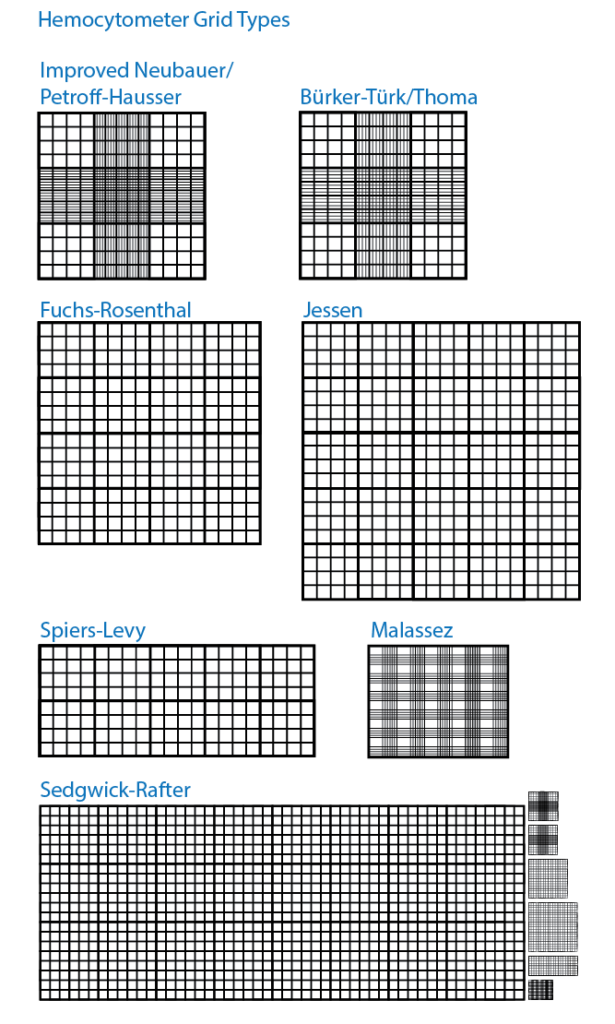You may be familiar with the ubiquitous Improved Neubauer hemocytometer, but did you know there are other options?
Most chambers are fairly similar in construction, but the grid patterns and depths differ. Note that the grid pattern can be independent of depth, and even the familiar Improve Neubauer can come in variants of different depths. Some features of each chamber may make them well-suited to different tasks, but some uses are more due to tradition than because the particular chamber is much better than another.
Fortunately, all chambers have made the sensible choice to make the basic unit 1 mm2, making calculating the volume per square relatively straightforward.

Improved Neubauer
The Improved Neubauer grid is the most common hemocytometer grid in use today. It is highly versatile, providing (9) 1×1 mm squares. The corners are subdivided into (16) 250×250 μm squares and the central square is subdivided into (25) 200×200 μm squares, each of which is further subdivided into (16) 50×50 μm squares. These different scales allow flexible counting of various concentrations and sizes of cells. They’re especially useful for mixed samples, like blood, which has numerous (red blood cells), few (white blood cells), and small (platelets) to count simultaneously. They typically have a depth of 0.1 mm, though other options are available.
Bürker-Türk/Thoma
The Bürker-Türk grid is similar to the Improved Neubauer grid, except the central square is divided into the same (16) 250×250 μm squares as the corners, and each of those is further subdivided into (16) 50×50 μm squares. You might note this isn’t an even division, and the reason is the next feature. Another key difference is additional grid lines have been added to indicate 200×200 μm squares inside each of the 250×250 μm squares, providing you a choice of sizes. The depth is usually 0.1 mm.
The Thoma grid is just the center square of the Bürker-Türk grid.
Fuchs-Rosenthal
The Fuchs-Rosenthal grid is a simple grid of (16) 1×1 mm, each further subdivided into (16) 250×250 μm squares. It has a depth of 0.2 mm. That means twice as much volume will fit in each square compared with a typical hemocytometer with a 0.1 mm depth. It is typically used for counting cells in cerebrospinal fluid.
Jessen
The Jessen grid is a simple grid of (25) 1×1 mm squares, each further subdivided into (16) 250×250 μm squares. They have additional lines dividing the large squares to provide additional size options. It has a depth of 0.4 mm. That means four times as much volume will fit in each square compared with a typical hemocytometer with a 0.1 mm depth. They’re often used for counting cells in cerebrospinal fluid and urine.
Spiers-Levy
The Spiers-Levy chamber contains a simple rectangular grid of (5×2) 1×1 mm squares, each of which are subdivided into (16) 250×250 μm squares. It has a depth of 0.2 mm, which means two times as much volume will fit in each square compared with a typical hemocytometer with a 0.1 mm depth. Its primary use has been for counting eosinophils in blood and cerebrospinal fluid.
Petroff-Hausser
The Petroff-Hausser chamber uses an Improved Neubauer grid but has a 0.02 mm depth. It is preferred for sperm counts and bacteria.
Malassez
The Malassez grid was the first version of the hemocytometer invented, created by its namesake. It is an irregular grid of (100) 200×250 μm rectangles, and alternating squares are further subdivided into (25) 40×50 μm rectangles. It has a depth of 0.2 mm, which means two times as much volume will fit in each square compared with a typical hemocytometer with a 0.1 mm depth.
Sedgwick-Rafter
This is a very different chamber intended for counting a total in a full 1.0 mL volume. It is a large cell of (50×20) 1×1 mm squares. It has a depth of 1.0 mm, for a total volume of 1.0 mL. This chamber is often used for analysis of water samples.
Which one do I need?
Which chamber is best for you? That depends on what you’re counting. Denser samples, if you can’t dilute them, requires smaller squares (and higher magnification). Smaller cells also benefit from smaller squares. More dilute samples benefit from larger chamber depths. However, unless you are doing something another chamber was specifically designed for, an Improved Neubauer chamber is likely to provide everything you need.
Get a Sidekick
Counting cells in any chamber can be tedious. You can check out my app, Hemocytometer Sidekick (iOS, Android), which provides options to count cells on almost any grid: Improved Neubauer, Bürker-Türk, Thoma, Fuchs-Rosenthal, Jessen, Spiers-Levy, Petroff-Hausser, and Malassez chamber.

Compre el app, pero quiero videoa comose usa
Claro, aquí tienes el vídeo: https://www.youtube.com/watch?v=JdB2lxvibS4